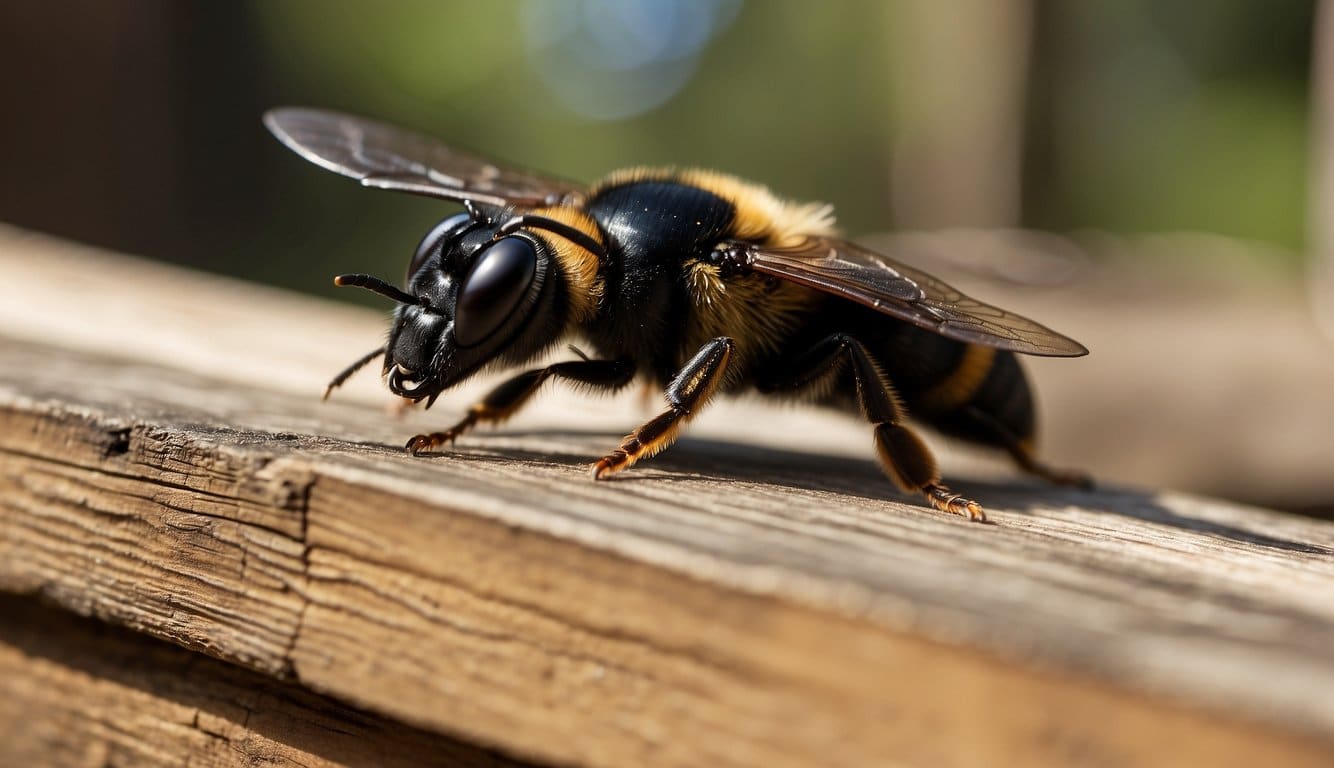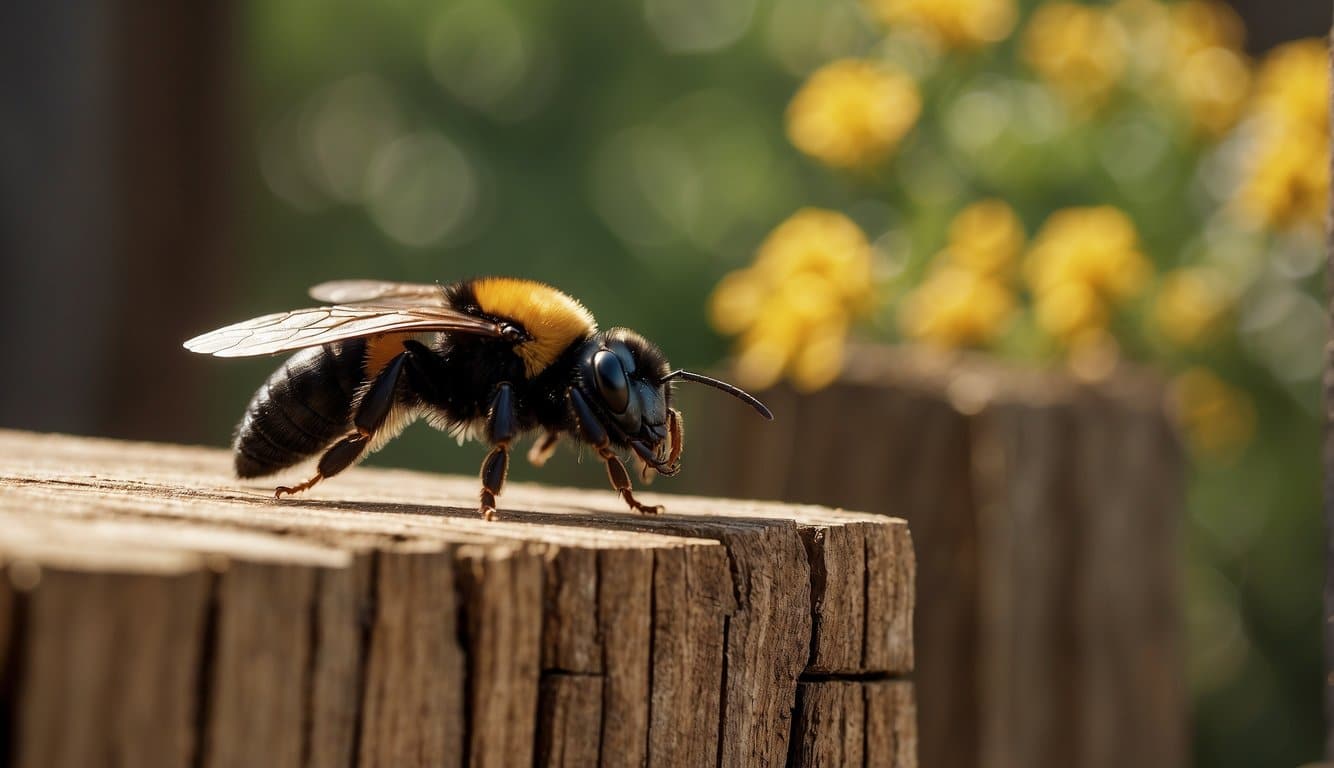Carpenter Bees are the worst. Every springtime they emerge from their holes to make life around the porch miserable. I’ve been there. Here’s what you can do to get these something holes out of your life!
Preventive Measures and Structural Protection
The best offense is a good defense, so we’re starting there.
Taking steps to deter carpenter bees from nesting can save your wooden structures from significant damage.
This section will guide you through the best practices to protect and maintain the integrity of your woodwork.
Importance of Paint and Wood Treatments
- Paint: Applying a fresh coat of paint to your wooden structures can be one of the most effective preventive measures.
- Carpenter bees prefer unfinished wood, so painting your decks, eaves, and siding can deter them from drilling into wood surfaces.
- Ensure that you cover all wooden exteriors thoroughly, giving special attention to corners and crevices where bees might seek to nest.
Wood Treatments
- Wood Treatments: Treating your wood with varnishes or stains can also serve as a deterrent.
- Treated wood is less appealing to carpenter bees, which can lead to a reduced risk of structural damage.
Choosing the Right Wood for Construction
When erecting new outdoor wooden features like fences, pergolas, or furniture, the choice of wood is vital:
- Cedar and Redwood: Opt for hardwoods such as cedar or redwood, which are naturally resistant to damage from water and pests.
- Avoid Pine and Fir: Softwoods like pine and fir are easier for bees to drill into and should be avoided when possible.
Physical Barriers and Maintenance
- Seal Entrance Holes: Plug existing holes with steel wool or wood putty to prevent bees from reusing them. This is essential after any bee activity has ceased.
- Regular Inspection and Repair: Perform routine checks on your outdoor features, looking for signs of wear, damage, or bee activity.
- Prompt repair and maintenance can go a long way in keeping your wooden assets safe and sound.
- Wood Grain Orientation: When constructing or replacing wooden items, align the wood grain vertically; carpenter bees prefer to target horizontal wood grain for nesting.
Effective Carpenter Bee Control Methods
To ensure your space is free from the buzzing nuisances, it’s key to employ effective strategies specifically targeting carpenter bees.
Trapping Techniques and Tips
- Utilize Carpenter Bee Traps: Carefully place ready-made carpenter bee traps near the areas of infestation.
- These traps mimic the natural nesting sites but prevent bees from escaping, reducing the population around your home.
- Make Your Own Trap: DIY enthusiasts can craft a trap using a wooden box, a plastic bottle, and some attractant.
- Drill holes into the box to lure them in, with the bottle attached below to trap them.
Chemical Treatments and Environmental Safety
- Use Insecticidal Dust and Sprays: Apply these products directly into the nest holes to eradicate larvae and adult bees.
- The use of insecticidal dust is especially effective as it sticks to the bees and is carried deeper into the colony.
- Ensure Safety for Pets and People: Always choose pesticides labeled as safe for home use and follow directions closely to protect your family and pets.
Natural Remedies and Alternatives
- Essential Oils and Citrus Sprays: Recipes including citrus oil or essential oils like almond oil can be natural deterrents for carpenter bees without harming the environment.
- Employ Diatomaceous Earth: This non-toxic powder can be sprinkled around bee-infested areas to safely get rid of carpenter bees.
- Sealing and Repairing: After treatment, seal all visible holes with caulk or wood putty mixed with sawdust to prevent future infestations.
Some “Outside the Box” Ideas
To effectively deter carpenter bees, consider adopting strategies that disrupt their preferred environment and nesting habits.
Utilizing methods that hinge on sound and creating conditions that are unfavorable to these bees can yield significant results.
Utilizing Sound and Vibration
Carpenter bees are not fond of noisy environments, so you might find success by:
- Installing wind chimes: The sound and vibration of wind chimes can discourage carpenter bees from nesting near your home.
- Playing loud music: An area with constant loud music may make it uncomfortable for carpenter bees to stay.
Creating Unfavorable Conditions
Make your property less inviting by:
- Making use of water and light: Areas that are frequently wet or well-lit tend to be less attractive to carpenter bees seeking a nesting place.
- Clear out stagnant water where possible, and consider installing additional lighting in dark areas like the attic.
- Maintain a sticky trap near known areas of carpenter bee damage to capture them before they cause more harm.
- Using natural repellents: Slice lemon or other citrus fruit peels and place them around your house, as the smell may act as a natural deterrent for these bees.
- Applying a solution of water and lemon peel can help prevent them from setting up residence.
Frequently Asked Questions
The following FAQs will guide you on natural deterrents, effective substances, preventive treatments, and do-it-yourself measures for carpenter bee control, as well as addressing concerns about stings and ground-dwelling bees.
What are effective natural remedies for deterring carpenter bees?
- Paint or stain outdoor wooden structures since carpenter bees prefer untreated wood.
- Apply a mixture of citrus essential oil into bee holes or on wood surfaces as bees tend to avoid these scents.
Which substances instantly kill carpenter bees?
- Insecticidal dust can be applied directly into the holes created by carpenter bees for instant and effective results.
- Vinegar solutions are a home remedy that can immediately affect carpenter bee larvae when sprayed into their nesting holes.
Can wood treatments prevent carpenter bee infestations?
- Sealing existing holes with caulk or putty can discourage carpenter bees from reusing them.
- Treating woods with residual liquids that deter insects can create a long-lasting barrier against infestations.
Are there any do-it-yourself solutions for permanently removing carpenter bees?
- Construct a trap that mimics potential nesting sites, which then confines the bees for relocation.
- Hang wind chimes near the affected areas; the noise and vibration may keep the bees at bay.
What methods are available for eradicating ground-dwelling bees?
For bees nesting in the ground:
- Water the area thoroughly as moist soil discourages nesting.
- Lay down a thick layer of mulch as a physical barrier to deter excavation and nesting activities.
Is it possible for carpenter bees to sting, and how does this influence removal methods?
- Male carpenter bees cannot sting, but females have that capability.
- However, they are generally not aggressive unless provoked.
- Safety gear should still be used as a precaution when attempting to remove or apply treatments to nests to avoid potential stings.
Last update on 2025-06-06 / Affiliate links / Images from Amazon Product Advertising API




